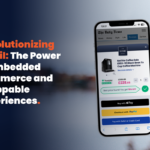3 common problems faced by publishers caused by affiliate marketing
In the fast-paced world of digital marketing, publishers often find themselves facing challenges that hinder the full realization of their revenue potential through affiliate marketing. There are three common problems encountered by publishers – Sales Conversion, Time on Site statistics and Hijacked Sales Commission. Embedded commerce offers a solution.
- Sales Conversion: The Redirect Conundrum
One prevalent issue for publishers in affiliate marketing is the traditional redirection of consumers to the retailer’s website. This redirects users away from the publisher’s site, forcing them to navigate the entire buying journey independently. Average e-commerce conversion rates sit around 2-4%, and this figure is significantly impacted when users are redirected, experiencing the standard conversion rates for e-commerce. This poses a substantial challenge for publishers aiming to maximize their revenue through affiliate marketing.
Solution: Embedded Commerce for Better Conversions
Embedded commerce resolves this issue by allowing consumers to complete transactions directly on the publisher’s site, eliminating the need for redirection. By integrating seamless shopping experiences within their content, publishers can significantly improve sales conversion rates, enhancing the overall effectiveness of their affiliate marketing efforts.
2. Time on Site: Navigating the Redirect Dilemma
Affiliate marketing’s inherent practice of redirecting users to retailer sites creates another challenge for publishers: a decline in the time users spend on their platforms. This decrease in time on site directly impacts key statistics that dictate the advertising rate card and revenue potential for publishers.
Solution: Embedded Commerce for Extended User Engagement
Embedded commerce not only addresses the conversion issue but also helps publishers keep users engaged on their platforms. By providing an integrated shopping experience, publishers can retain users’ attention, leading to improved time-on-site statistics. This extended user engagement positively influences the advertising rate card, allowing publishers to charge higher rates for advertising across their site.
3. Hijacked Sales Commission: The Attribution Predicament
The third common problem faced by publishers in affiliate marketing is the risk of losing sales commission due to voucher/discount code entries. When consumers are redirected to a retailer and asked for a code, the original source of inspiration loses out on potential earnings as the commission is directed away.
Solution: In-Context Vouchers with Embedded Commerce
Shopthru comes to the rescue by offering in-context voucher codes, eliminating the risk of attribution issues through last-click attraction. Publishers can integrate voucher code options seamlessly within their content, ensuring that the original source of inspiration receives due credit for the sale. This not only safeguards the publisher’s earnings but also fosters a more transparent and fair affiliate marketing ecosystem.
Conclusion:
As publishers navigate the complexities of affiliate marketing, embracing embedded commerce emerges as a strategic solution to overcome common challenges. By integrating seamless shopping experiences, publishers can enhance conversion rates, retain user engagement, and safeguard their earnings in a competitive digital landscape. As the industry continues to evolve, Shopthru is at the forefront of embedded commerce, unlocking new opportunities for publishers to thrive in the affiliate marketing arena.
#AffiliateMarketingIssues #DigitalPublishing #ContentCreators #AffiliatePrograms #RevenueGeneration #ContentMonetization #DigitalMarketingChallenges #PublisherStruggles #AffiliateMarketingTips #ContentStrategy #OnlineMonetization #MarketingStrategies #MonetizationStrategies #DigitalContentCreators




Leave a Reply
Want to join the discussion?Feel free to contribute!